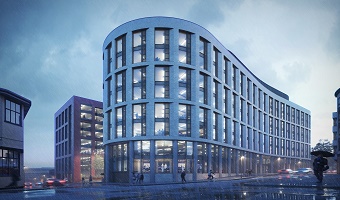The Midlands Engine Office Market Report 2017 says that in Nottingham, Derby and Leicester, 86%, 89% and 74% respectively of activity in the sector was at the smaller end of the market in the past 12 months. While this is not untypical of the region’s market, the type of occupier responsible for this take up is changing.
The report, which focuses on eight key regions in the Midlands Engine area: Birmingham city centre, Birmingham out of town, Coventry, Derby, Leicester, Nottingham, Milton Keynes and Northampton, says the first half of 2017 in the East Midlands has been more positive after a subdued 2016.
However, Phil Quiggin, director at LSH Nottingham, said Derby had to attract new-build schemes or good quality refurbished office stock to satisfy current requirements and to attract good quality tenants.
“Nottingham has seen no speculative office development for several years however delivery of the mixed office and laboratory building at BioCity, known as the Discovery building, has bucked the trend. The building has just been completed and is already 80% occupied”
“Derby is starting to attract technology and innovation occupiers and the iHub at Infinity Park has been very successful,” he said. “We anticipate that Infinity Park will continue to lead the way and speculative development on this site may well occur in the next 12 months triggering a step-change in prime headline rents.”
Similarly in Loughborough, the University’s Science & Enterprise Park has seen unprecedented activity over the last 12 months following completion of the Advanced Technology Innovation Centre and further lettings within the Charnwood Campus.
Derby saw 80,000 sq ft take up in 2016, which was a 47% decrease compared with 2015. The number of deals was also weak at just 27 transactions. However, Q1 2017 saw in take-up of 41,000 sq ft across 19 deals, with professional services being the main driver of demand.
Availability has halved from its 2014 peak and now stands at a ten-year low of about 395,000 sq ft, which equates to 2.4 years of supply. This is among the lowest figure in the region.
“Churn of second-hand space is characteristic of the market and, due to a lack of supply, 2016 was the second successive year without either a single grade A deal or a deal above 10,000 sq ft,” said Phil.
“Almost half of availability requires extensive refurbishment, further increasing pressure on supply, while a lack of development has left the market starved of grade A space, which accounts for only 10% of total supply.”
The report points out that there is an erosion of office supply due to redevelopment projects, particularly conversion to city centre residential and managed student accommodation, while a lack of prime space means there are no speculative developments under construction or in the pipeline.
In Leicester, the office market has experienced a subdued Q1 2017. Although demand is stable, a lack of new stock means that take-up for 2017 is unlikely to surpass the annual average of 263,000 sq ft.
Demand for good quality office accommodation is also outstripping supply and is focused out-of-town, particularly on the business parks adjacent to Junction 21 of the M1, says the report.
Opportunities exist to kickstart further development but it requires more pre-lets at phase 2 of Watermead Business Park, which is the only premium office development on the north side of the city and is well connected to main arterial roads.
There is additional good news with the announcement of the Loughborough and Leicester Science and Innovation Enterprise Zone, which is expected to attract business, investment and development. The three sites – two in Loughborough and one in Leicester – will support science and hi-tech manufacturing businesses over the next 25 years.
The report says that office activity in Nottingham is being constrained by a shortage of grade A supply, although refurbished accommodation is expected to attract occupiers and lead to an increase in take-up this year compared to 2016. There are unlikely to be any announcements about speculative development in the next 12 to 18 months.
Existing availability is heavily weighted by grade B accommodation, which accounts for almost two thirds of total stock, it adds.
“Nottingham’s office market continues to rely on refurbishment of existing stock to satisfy the local market, which goes some way to make up for the lack of new build in recent years,” said Phil.
“However, it does not provide the large modern floorplates that would appeal to some of the city’s large occupiers many of whom are currently situated in relatively poor quality accommodation.”
He welcomed the extension of BioCity, but says it does not provide conventional office space or cater for the wider market.
“Nottingham offers some excellent development sites, including Station Street, Unity Square, Guildhall, Angel Row and the Eastside area, but they require significant investment in order to be brought forward,” added Phil. “They also need to reflect the change in occupier type and provide collaborative environments that cater for the ever growing technology sectors and their ways of occupying space”.
In 2016, Nottingham city centre and out-of-town markets combined recorded take-up of 354,183 sq ft, its lowest level since 2011, and take-up was subdued in the second half of last year.
Q1 of 2017 has also been quiet, with transactions totalling 67,809 sq ft, compared with 76,733 sq ft the same time last year.
Out-of-town demand accounted for approximately two-thirds of take-up in the past 12 months although there were no out-of-town grade A transactions over 10,000 sq ft.
Phil concluded: “The opportunities for growth and return on investment are abundant in the Midlands Engine region, we just need to be strategic about how we approach them. With this in mind, a forensic understanding of the market remains critical.”
For more information on the East Midlands office market, please contact Phil Quiggin or download the full report HERE >.
REGISTER FOR UPDATES
Get the latest insight, event invites and commercial properties by email







